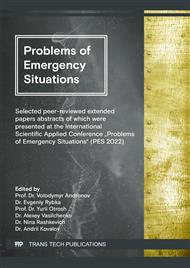[1]
S.M. Logvinkov, I.A. Ostapenko, O.N. Borisenko, O.B. Skorodumova, A.A. Ivashura, Prediction of melting paths of wollastonite-containing compositions, China's Refractories, 29–3 (2020) 13–18.
Google Scholar
[2]
Melting points of hydrocarbons, alcohols and acids. Engineering ToolBox. https://www.engineeringtoolbox.com/melting-temperature-hydrocarbons-alkane-alkene-benzene-aromatic-alcohol-acid-naphthalene-d_1965.html.
Google Scholar
[3]
D. Tregubov, О. Tarakhno, D. Sokolov, F. Trehubova, The identification of hydrocarbons cluster structure by melting point, Problems of Emergency Situations, 2 (34) (2021) 94–109.
Google Scholar
[4]
K. Yang, Zh. Cai, A. Jaiswal, M. Tyagi, J.S. Moore and Y. Zhang, Dynamic Odd–Even Effect in Liquid n-Alkanes near Their Melting Points. Angewandte сhemie, 55–45 (2016) 14090-14095.
DOI: 10.1002/anie.201607316
Google Scholar
[5]
R. Boese, H.-Ch. Weiss, D. Bläser, The Melting Point Alternation in the Short-Chain n-Alkanes: Single-Crystal X-Ray Analyses of Propane at 30 K and of n-Butane to n-Nonane at 90 K, Angewandte сhemie, 38–7 (1999) 988–992.
DOI: 10.1002/(sici)1521-3773(19990401)38:7<988::aid-anie988>3.0.co;2-0
Google Scholar
[6]
E.T. Atume, Absolute Prediction of the Melting and Freezing Points of Saturated Hydrocarbons Using Their Molar Masses and Atume's Series, Advanced Journal of Chemistry-Section A, 3–2 (2020) 122–130.
DOI: 10.33945/sami/ajca.2020.2.2
Google Scholar
[7]
H. Li, H. Higashi, K. Tamura, Estimation of boiling and melting points of light, heavy and complex hydrocarbons by means of a modified group vector space method, Fluid Phase Equilibria, 239–2 (2006) 213–222.
DOI: 10.1016/j.fluid.2005.11.004
Google Scholar
[8]
V.R. Thalladi and R. Boese, Why is the melting point of propane the lowest among n-alkanes? New J. Chem., 24 (2000) 579–581.
DOI: 10.1039/b004283h
Google Scholar
[9]
Y. Hapon, M. Chyrkina, D. Tregubov, O. Romanova, Co-Mo-W galvanochemical alloy application as cathode material in the industrial wastewater treatment processes, Materials Science Forum, 1038 (2021) 251–257.
DOI: 10.4028/www.scientific.net/msf.1038.251
Google Scholar
[10]
I. Yu. Doroshenko, Spectroscopic study of cluster structure of n-hexanol trapped in an argon matrix. Low Temperature Physics, 3-6 (2017) 919–926.
DOI: 10.1063/1.4985983
Google Scholar
[11]
P. Laszlo, Logique de la synthese organique, 1 (1993) 208.
Google Scholar
[12]
D. Tregubov, О. Tarakhno, О. Kireev, Influence of cluster structure of liquids technical mixtures on the value of characteristic temperatures, Problems of Emergency Situations, 28 (2018) 99–110.
Google Scholar
[13]
O. Skorodumova, O. Tarakhno, O. Chebotaryova, O. Bezuglov, F.M. Emen, The use of sol-gel method for obtaining fire-resistant elastic coatings on cotton fabrics, Materials Science Forum, 1038 (2021) 468–479.
DOI: 10.4028/www.scientific.net/msf.1038.468
Google Scholar
[14]
O. Kireev, D. Tregubov, S. Safronov, D. Saveliev, Study insulating and cooling properties of the material on the basis of crushed foam glass and determination of its extinguishing characteristics with the attitude to alcohols, Materials Science Forum, 1006 (2020) 62–69.
DOI: 10.4028/www.scientific.net/msf.1006.62
Google Scholar
[15]
D. Tregubov, О. Tarakhno, D. Sokolov and F. Trehubova, The oscillation of n-alkanes characteristic temperatures under the action the cluster structure of substance, Problems of Emergency Situations, 32 (2020) 14–30.
Google Scholar



